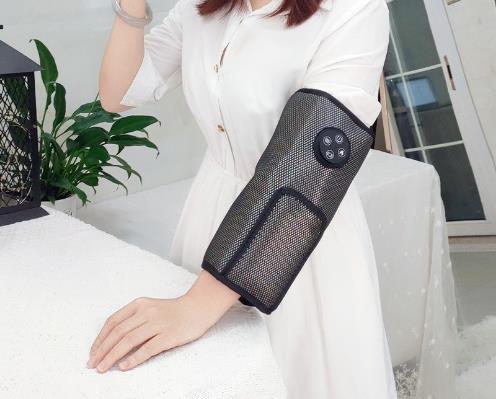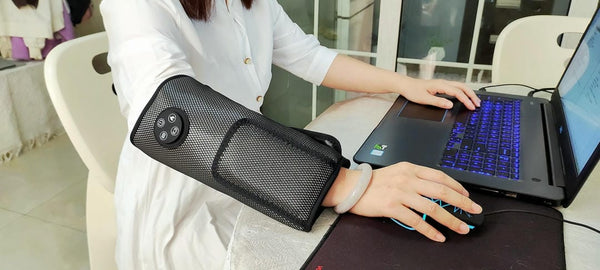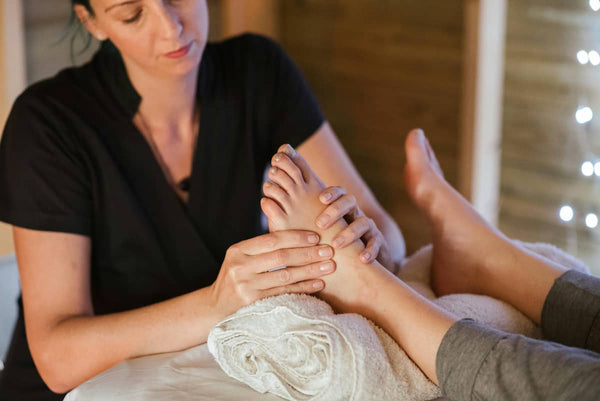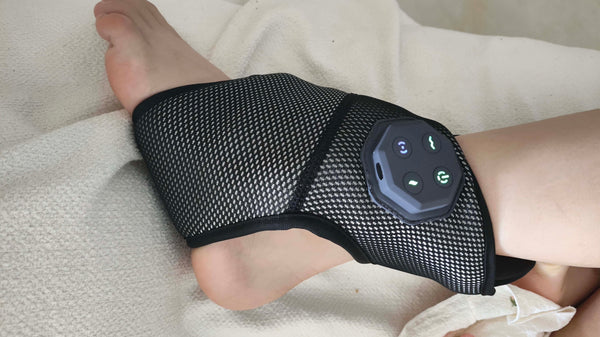
Alright, fitness warriors! You push, you pull, you squat till you drop. And sometimes, your lower back screams louder than your drill sergeant after a particularly grueling session. That deep ache, that infuriating stiffness – it’s the uninvited guest after a killer workout or maybe just from trying that new "revolutionary" (read: probably ill-advised) exercise your buddy swore by. We get it; as folks who spend our days (and sometimes nights) thinking about how to make bodies feel better, we’ve heard countless stories from fitness enthusiasts about how lower back pain can throw a massive wrench in your training schedule, not to mention your general ability to bend over and tie your shoes without groaning like a rusty gate.
But what if you had a secret weapon in your recovery arsenal, something to help you fight back? Enter the mighty heated back massager. Now, I know what some of you hardcore gym-goers might be thinking – "another fluffy gadget for the shelf?" But hear me out. From our perspective as product developers constantly iterating on designs, these aren't just fancy vibrating cushions designed to lull your grandma to sleep. We design them with active bodies in mind, aiming to combine that blissful, penetrating warmth with targeted massage to help you bounce back faster and hit those PBs. It's about bringing a bit of that physio magic, that therapeutic touch, right into your own home gym or living room, without the awkward small talk or the eye-watering invoices. This piece will break down how a quality heated back massager might just become your new favorite training partner, helping you manage those aches and keep you in the game.
What's the Deal with Lower Back Pain Anyway?
So, what's actually going on when your lower back decides to impersonate a concrete slab after a heavy deadlift day or an ambitious new yoga pose? For fitness enthusiasts, lower back pain often stems from a few usual suspects. Overexertion is a big one – you know, that "one more rep" that your ego demanded but your lumbar spine was less keen on. Improper form during exercises, especially compound lifts, can place undue stress on the delicate structures of your lower back, leading to muscle strains, ligament sprains, or even more serious issues if you're not careful. Think of your spine as a high-performance engine; it needs to be tuned and used correctly, otherwise, things can go sideways, fast.
Then there's the classic Delayed Onset Muscle Soreness (DOMS), that familiar ache that creeps in 24-48 hours post-exercise, making you wince with every step. While DOMS is a sign your muscles are adapting and growing (go you!), when it hits the lower back, it can be particularly debilitating. Sometimes, it's not even an acute injury but the accumulation of micro-trauma from repetitive movements or sustained postures during certain sports. And let’s not forget those pesky massager for lumbar muscle knots – those tight, irritable bands of muscle tissue that feel like little gremlins are having a party in your back. These can develop from chronic tension or acute strain, causing localized pain and sometimes referring pain to other areas. It's like your muscles are holding a grudge, and they're not afraid to show it.
Understanding these common culprits is the first step. For a fitness enthusiast, your back is core to, well, almost everything you do. From powerlifting to pilates, a strong and healthy back is non-negotiable. Therefore, managing and preventing lower back pain isn't just about comfort; it's about performance, longevity in your sport, and maintaining your active lifestyle. That's where targeted recovery tools, like a heated back massager, can play a really, really important supporting role.
- Overexertion: Pushing muscles beyond their current capacity.
- Improper Form: Incorrect technique during exercises placing uneven stress on the back.
- Muscle Strains/Sprains: Acute injuries from sudden movements or heavy loads.
- Delayed Onset Muscle Soreness (DOMS): Post-exercise muscle soreness.
- Repetitive Stress: Micro-trauma from repeated motions in sports.
- Development of tight lumbar muscle knots.
The Magic Behind the Warm Hug: Science of a Heated Back Massager
So, how does this "warm hug" for your back actually work its magic? It's not voodoo, I promise, though sometimes it feels like it! The effectiveness of a heated back massager comes down to a tag-team effort of two well-established therapeutic principles: heat therapy and massage therapy. When we're designing these devices, we're essentially trying to replicate and automate what a good therapist might do, but in a package you can use while binge-watching your favorite series. First up, let's talk heat. The "heated" part is crucial. Applying warmth to the lower back promotes vasodilation – fancy talk for widening your blood vessels.
This increased blood flow is a game-changer for sore muscles. It brings more oxygen and vital nutrients to the tired, damaged tissues and, just as importantly, helps to flush out metabolic waste products and inflammatory mediators that accumulate after intense exercise and contribute to that lovely ache and stiffness. Some advanced models even use an infrared heated back massager system, which proponents claim can penetrate deeper into the muscle tissue than surface heat, though the core benefit remains improved circulation and tissue warming. This warmth also has a wonderful effect on muscle pliability; it's like warming up taffy, making it softer and more stretchable. This primes your muscles beautifully for the second part of the equation: the massage itself. You'll often find an adjustable heat back massager feature, which is great because not everyone likes their back quite so toasty.
Then comes the mechanical massage. This can range from rotating shiatsu nodes designed to mimic the thumbs and fingers of a masseuse, to invigorating vibration, or even percussive movements in some models. These actions work to physically knead and manipulate the muscle tissue. This helps to break down those stubborn lumbar muscle knots (also known as trigger points), release tension, reduce muscle spasms, and further stimulate circulation. It’s about getting in there and encouraging those tight, grumpy muscle fibers to chill out a bit. The combination of heat preparing the muscles and the massage working out the kinks offers a synergistic effect, making the whole experience more effective than either therapy on its own. It's a bit like a good cop/bad cop routine for your muscle tension – heat is the good cop, lulling it into a false sense of security, then massage comes in to lay down the law.
- Heat Therapy: Promotes vasodilation, increasing blood flow to deliver oxygen and nutrients, and remove waste products. Softens and relaxes muscle tissue.
- Massage Therapy: Mechanically kneads muscles to release tension, break down adhesions (knots), and improve local circulation.
- Synergistic Effect: Heat enhances muscle receptiveness to massage, making it more effective and comfortable.
- Technological Variety: Includes options like an infrared heated back massager for potentially deeper heat and various massage mechanisms (shiatsu, vibration).
Not All Aches are Created Equal: Massager Applications (Even for Endometriosis Pain?)
 One of the cool things we see as product developers is the sheer variety of ways people use these tools. For fitness enthusiasts, the primary application of a heated back massager is pretty clear: post-workout recovery. After you’ve thrashed your back with deadlifts, squats, or even a long run, it can be a godsend for soothing those screaming muscles and reducing next-day stiffness. It’s also brilliant for general muscular tension that can build up from, say, sitting at a desk all day *before* you even hit the gym. Using it preventatively or for general maintenance can help keep your back feeling more supple and less prone to those "oops, I think I pulled something" moments.
One of the cool things we see as product developers is the sheer variety of ways people use these tools. For fitness enthusiasts, the primary application of a heated back massager is pretty clear: post-workout recovery. After you’ve thrashed your back with deadlifts, squats, or even a long run, it can be a godsend for soothing those screaming muscles and reducing next-day stiffness. It’s also brilliant for general muscular tension that can build up from, say, sitting at a desk all day *before* you even hit the gym. Using it preventatively or for general maintenance can help keep your back feeling more supple and less prone to those "oops, I think I pulled something" moments.
Now, here’s where things get interesting, and it touches on the "Controversial Focus" you mentioned regarding lower back massage for endometriosis pain. While a heated back massager is primarily designed for muscular aches and pains, we do hear anecdotal feedback about its use for other types of discomfort where back pain is a symptom. For example, Perspective 1 noted that some users with endometriosis reported significant relief from multi-functional waist massagers, like certain Klcosy heated massager settings (or similar devices). This makes sense in that heat and gentle massage can be soothing for many types of pain, and if endometriosis is causing referred pain or muscle tension in the lower back, then a massager might offer some comfort. However, it's super important to distinguish this from treating the underlying condition. We're talking symptom management here, not a cure.
Conversely, Perspective 2 mentioned a user finding a simple heating pad more effective than a mechanical massager for their specific situation. This highlights a key point: pain is personal, and what works wonders for one person might be "meh" for another. If inflammation is a major component, perhaps intense mechanical massage isn't ideal, and gentle, consistent heat is preferred. This is why having an adjustable heat back massager with various intensity settings is so valuable – it allows for personalization. The takeaway for fitness folks is that while these devices are great for your typical muscle woes, if you're dealing with pain from other medical conditions, a heated back massager might offer some relief, but it's crucial to manage expectations and always consult with a healthcare professional for the primary condition. It's a tool, not a magic wand, unfortunately!
- Post-Workout Recovery: Alleviating soreness and stiffness after intense exercise.
- General Muscle Tension: Relieving aches from daily activities or prolonged sitting.
- Targeting Specific Knots: Working on tight lumbar muscle knots.
- Potential Symptomatic Relief: Some users report benefits for referred back pain from conditions like endometriosis (anecdotal, consult doctors for primary conditions). It's one of the heated back massager benefits that users discover.
- Warm-up Aid: Gentle heat and massage can prepare muscles for activity, though not a replacement for dynamic warm-ups.
Don't Go Wild: Using Your Heated Back Massager Like a Pro
Alright, so you’re sold on the idea and ready to give your back some much-needed TLC with a heated back massager. Fantastic! But before you crank it up to "volcano heat" and "jackhammer intensity," let's talk about using it safely and effectively. Remember Perspective 3: "Be careful to avoid high-intensity Settings, as this may aggravate inflammation." This is golden advice, especially for us fitness types who sometimes have a "more is better" mentality. Your back isn't a stubborn jar lid; you don't need to force it. Start slow and gentle, especially if you're new to it or your back is particularly tender. Most devices, especially a good adjustable heat back massager, will have multiple settings for both heat and massage intensity. Think of it like starting a new exercise program – you wouldn’t go for a world record on day one, would you?
Listen to your body. The goal is therapeutic relief, not an endurance test. If it feels painful or uncomfortable, dial it back or stop. A typical session might last anywhere from 15 to 30 minutes. Some devices, if they have specific **Klcosy heated massager settings** or similar, might even have pre-programmed routines with varying intensities. Using it for shorter, regular sessions is often more beneficial than one marathon session that leaves you feeling bruised. And hydrate! Just like after a manual massage, drinking water can help flush out any toxins that might have been released from your muscle tissues. Also, make sure you're positioning the massager correctly to target the areas that need it most – usually the fleshy parts of your lower back, avoiding direct, prolonged pressure on the spine itself.
Another pro tip: integrate it into your routine. Maybe it's part of your cool-down after every workout, or a wind-down ritual before bed. Consistency is key to reaping the long-term heated back massager benefits. And don't forget that a massager is just one piece of the puzzle. Combine its use with good posture, proper lifting techniques, regular stretching, and core strengthening exercises for a holistic approach to back health. If you're using an infrared heated back massager, the same principles apply – start gently and listen to your body’s feedback. The aim is to feel better, stronger, and ready for your next fitness challenge, not to add "massager-induced injury" to your list of complaints.
Key Usage Guidelines:
- Start Low and Slow: Begin with the lowest heat and massage intensity settings.
- Listen to Your Body: If it hurts, reduce intensity or stop. "No pain, no gain" doesn't apply here.
- Optimal Duration: 15-30 minutes per session is generally recommended. Avoid overly long sessions.
- Correct Positioning: Ensure the massager targets the muscles of the lower back, not directly on the spine.
- Hydrate: Drink water after your session.
- Be Consistent: Regular use yields better results than sporadic, intense sessions.
- Holistic Approach: Combine with good posture, stretching, and strengthening exercises.
When Your Massager Waves the White Flag: Seeking Professional Help
As much as we design these heated back massager units to be fantastic tools for relief and recovery, it's crucial to know their limits and when it's time to call in the cavalry – i.e., a healthcare professional. Think of your massager as a very skilled first-aider for your muscles; it can handle a lot of common aches and stiffness, but it's not a substitute for a doctor or a physical therapist if something more serious is going on. If your back pain is severe, came on suddenly after a specific injury or trauma, or doesn't start to improve after a few days of sensible self-care (including using your massager), it’s time to get it checked out.
Other red flags include pain that radiates down your leg (especially if it goes below the knee), numbness or tingling in your legs or feet, weakness in your legs, or any changes in bowel or bladder function. These could indicate nerve compression or a more significant spinal issue that a massager simply isn't equipped to deal with – and could potentially worsen if you're not careful. Also, if you have pre-existing conditions like osteoporosis, arthritis, a history of spinal surgery, or are pregnant, it’s always best to have a chat with your doctor before introducing any new therapeutic device, including even the gentlest heated back massager. They can provide guidance tailored to your specific health profile.
The goal is to use your massager to enhance your well-being and support your fitness journey, not to mask a problem that needs medical attention. We want you to enjoy all the heated back massager benefits safely. So, be smart, listen to those body signals, and don't hesitate to seek professional advice when needed. Your back will thank you for it in the long run, and you'll be back to crushing those workouts much sooner and safer. Consider an infrared heated back massager or any type as a tool, but your doctor as the chief strategist for serious concerns.
- Severe or Sudden Onset Pain: Especially after an injury.
- Pain Radiating Down the Leg: Sciatica-like symptoms.
- Numbness, Tingling, or Weakness: In legs or feet.
- Changes in Bowel/Bladder Function: A serious red flag.
- Pain That Worsens or Doesn't Improve: Despite self-care.
- Pre-existing Medical Conditions: Always consult your doctor first.
Frequently Asked Questions (The Burning Questions!)
Does heat worsen back inflammation?
This is a great question, and the answer is nuanced. For acute inflammation (think a fresh injury, very red, swollen, and hot), applying more heat can sometimes increase blood flow to an already overwhelmed area and potentially make the inflammation worse in the very short term. In these initial stages (first 24-48 hours), cold therapy is often recommended to reduce swelling. However, for chronic inflammation or muscle soreness where the acute phase has passed, heat can be very beneficial. It helps to relax tight muscles, increase circulation to bring healing nutrients, and can soothe discomfort. Many heated back massager users find relief for chronic stiffness which may have an inflammatory component. If you're unsure, or dealing with significant inflammation, it's always best to consult a healthcare professional. An adjustable heat back massager allows you to start very low if you are concerned.
How long should you use a heated massager?
Generally, for a heated back massager, session durations of 15 to 30 minutes are recommended. Most devices also have an auto-shutoff feature, often around the 15-20 minute mark, as a safety precaution. Using it for extremely long periods in one go isn't necessarily more beneficial and could potentially lead to skin irritation from the heat or muscle soreness from over-stimulation. Consistency is more important than duration; shorter, regular sessions (e.g., daily or several times a week) tend to provide better long-term results for managing chronic pain or stiffness, and for reaping ongoing heated back massager benefits for those pesky lumbar muscle knots.
Can Klcosy's heat mode penetrate deep tissues compared to clinical therapies?
When we talk about heat penetration, it's important to differentiate between consumer devices like a Klcosy heated massager (or similar brands featuring an infrared heated back massager element) and clinical therapeutic modalities like therapeutic ultrasound or diathermy used by physiotherapists. While infrared heat, which some consumer massagers use, is designed to penetrate a bit deeper into the muscle tissue than standard conductive heat (like a simple hot water bottle), it generally won't reach the same depths or have the same focused intensity as specialized clinical equipment. Clinical therapies are administered by trained professionals who can target specific tissue depths and deliver higher energy levels safely. So, while the heat from a good quality home heated back massager can be very effective for muscle relaxation and improving superficial blood flow, and provide excellent heated back massager benefits for general aches, it's not a direct equivalent to the deep heat penetration achieved in a clinical setting for more significant therapeutic interventions.
So, there you have it, fitness fanatics! The lowdown on how a heated back massager can be a seriously valuable player in your recovery game plan. From soothing those post-workout aches to tackling stubborn lumbar muscle knots, the combination of targeted heat and massage offers a potent one-two punch against lower back discomfort. As product folks, we're always striving to create tools that genuinely help people feel and perform better, and we believe a well-designed heated back massager fits that bill perfectly for the active individual. It’s about making effective recovery more accessible and convenient.
Remember to use it wisely – start gentle, listen to your body, and don't expect it to be a magic bullet for every single ache or underlying medical condition (especially complex ones like endometriosis-related pain, where experiences vary). But as part of a sensible, holistic approach to your fitness and well-being, incorporating a heated back massager can definitely help you stay more comfortable, more mobile, and ultimately, more consistent in chasing those fitness goals. Now go forth and conquer... and maybe give your back a nice, warm massage afterwards. You've probably earned it!
This reply is generated based on currently verifiable public information and general knowledge about back massagers. The information provided is for general informational purposes only and does not constitute medical advice. It is recommended to cross-check key content with authoritative sources and consult with a healthcare professional for any health concerns or before making any decisions related to your health or treatment. The mention of any specific brand names, such as Klcosy, is for illustrative purposes based on the input provided and does not constitute an endorsement. Always refer to manufacturer guidelines for specific product usage.




0 comments